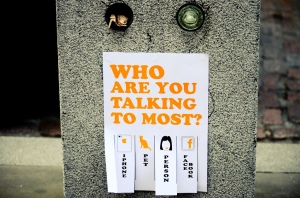 Before the internets were invented life must have been so dull. Y’know, really dull.
Before the internets were invented life must have been so dull. Y’know, really dull.
You wrote a press release, you organised a photocall and once in a while TV and radio would show an interest.
A few years back the yardstick of success where I work was getting the local TV news to come host the weather live from your patch.
There’s been a change. Like a glacier edging down the mountain valley blink and not much has happened. Come back a while later and things have unstoppably changed.
Truth is, it’s a fascinating time to be a comms person. We’re standing at the intersection between old and new.
Former Sunday Times editor Harold Evans once said that he loves newspapers but he’s intoxicated by the speed and possibility of the internet. That’s a quote I love.
 Here’s another quote I love. Napoleon Dynamite once said that girls only like men with skills. Like nunchuck skills, bo staff skills or computer hacking skills. For a digital comms perspective Napoleon’s quote could be applied there too. What you need are social media skills, press release skills and interactive mapping skills. And a bit more.
Here’s another quote I love. Napoleon Dynamite once said that girls only like men with skills. Like nunchuck skills, bo staff skills or computer hacking skills. For a digital comms perspective Napoleon’s quote could be applied there too. What you need are social media skills, press release skills and interactive mapping skills. And a bit more.
Sitting down recently I calculated the many strings to the bow that are now needed. I counted 37 skills, abilities and platforms I’m either using on a regular basis or need to know. Some more than others. Or to use Napoleon’s parlance, bow skills.
Out of interest, and to save me time in googling their associated links, here they are:
TIMELESS SKILLS
The ability to understand the detail and write in plain English.
The ability to understand the political landscape.
The ability to communicate one-to-one and build relationships.
The ability to work to a deadline.
The ability to understand comms channels and what makes interesting content on each.
WRITTEN CONTENT
Write a press release. The ability to craft 300 words in journalese with a quote that’s likely to tickle the fancy of the journalist who you are sending it to.
 Use Twitter. To shape content – – written, audio, images and video – in 140 characters that will be read and shared.
Use Twitter. To shape content – – written, audio, images and video – in 140 characters that will be read and shared.
Use Facebook. To shape content – written, audio, images and video – that will be read and shared.
Use Wikipedia. To be aware of what content is being added knowing that this belongs to wikipedia.
Use LinkedIn. To shape content – written, audio, images and video – that will be read and shared.
IMAGES
Arrange a photocall. The ability to provide props and people to be photographed and to work with a photographer and those being photographed so everyone is happy.
Use Flickr. To source pics, to post pics to link to communities, to arrange Flickr meets.
Use Pinterest. To source pics and share your content. To build a board around an issue or a place.
Use Instagram. To share your pics.
AUDIO
Arrange a broadcast interview. The ability to provide an interviewee when required and give them an understanding of the questions and issues from a journalists’s perspective.
 Record a sound clip to attach to a release, embed on a web page or share on social media. I like audioboo. I’m increasingly liking soundcloud too. It’s more flexible to use out and about.
Record a sound clip to attach to a release, embed on a web page or share on social media. I like audioboo. I’m increasingly liking soundcloud too. It’s more flexible to use out and about.
VIDEO
Create and post a clip online and across social sites. Using a camera or a Flip camera. With YouTube or Vimeo.
WEB
Add content to a webpage. That’s the organisation’s website via its CMS.
Build a blog if needs be or add content to a blog. That’s a blog like this one or a microsite like this one.
 To know and understand free blogging tools. Like wordpress or tumblr.
To know and understand free blogging tools. Like wordpress or tumblr.
COMMUNITY BUILDING
To know when to respond to questions and criticism and how. The Citizenship Foundation’s Michael Grimes has done some good work in this field.
To know how to build an online community. Your own. And other communities.
HYPERLOCAL
To engage with bloggers. Like Wolverhampton Homes’ policy suggests.
To be search for blogs to work with. On sites like openly local.
LISTENING
 To be aware of what’s being written about your organisation, issue, campaign or area. By tools like Google Alerts.
To be aware of what’s being written about your organisation, issue, campaign or area. By tools like Google Alerts.
MAPPING
To build and edit a simple map. Like a Google map. And be aware of other platforms like Open Street Map.
ADVERTISING
To understand the landscape to know which audience reads which product. Like the local paper, Google Adwords and Facebook advertising.
MARKETING
To understand when print marketing may work. Like flyers or posters. Yes, even in 2012 the poster and the flyer are sometimes needed as part of the comms mix.
To understand when information can be better presented visually. Through a simple piechart. Or more interestingly as a word cloud or via wordle. Or if its packets of data in spreadsheets or csv files through things like Google Fusion Tables or IBM’s exploratory Many Eyes.
OPEN DATA
To understand what it is and how it can help. It’s part of the landscape and needs to be understood. Internet founder Tim Berners-Lee’s TED talk is an essential six minutes viewing.
NEWSLETTERS
To understand what they are and how they can work. In print for a specific community like an estate or a town centre or via the free under 2,000 emails a month platform mailchimp to deliver tailored newsletters by email. There’s the paid for govdelivery that some authorities are using.
CURATION
 To make sense of information overload and keep a things. With things like pinboard.in you can keep tabs on links you’ve noticed. Here’s mine you can browse through. For campaigns and useful interactions you can also use storify to curate and store a campaign or event. You can then embed the storify link onto a web page.
To make sense of information overload and keep a things. With things like pinboard.in you can keep tabs on links you’ve noticed. Here’s mine you can browse through. For campaigns and useful interactions you can also use storify to curate and store a campaign or event. You can then embed the storify link onto a web page.
SOCIAL MEDIA
To know the right channels for the right comms. Social media shouldn’t just be a Twitter and Facebook tick box exercise. It should be knowing how and why each platforms works for each audience. Same goes for the smaller but important platforms like Pinterest, Google+, Instagram, LinkedIn and Flickr.
HORIZON SCANNING
To know what’s on the horizon and be prepared for it when it lands. Same for emerging fields like Augmented Reality. What is science fiction today will become commonplace in years to come. People like hyperlocal champions Talk About Local who are already working in this field.
ANALYTICS
To know how to measure and when to measure. The measurement for traditional comms have been around. Potential readership of newspapers. Opportunities to view. Opportunities to see. The new digital landscape doesn’t quite fit this and new ways are being worked out. There isn’t an industry standard means just yet. But the gap has been filled by those who claim to be. The very wise Dr Farida Vis, who took part in the Guardian’s acclaimed research into the English  riots of 2011, pointed out that sentiment analysis wasn’t more than 60 per cent accurate. There’s snake oil salesmen who will tell you otherwise but I’ve not come across anything that will be both shiny and also impress the chief executive. Tweetreach is a useful tool to measure how effective a hashtag or a tweet has been. Google Alerts we’ve mentioned. Hashsearch is another useful search tool from government digital wizards Dave Briggs and Steph Gray.
riots of 2011, pointed out that sentiment analysis wasn’t more than 60 per cent accurate. There’s snake oil salesmen who will tell you otherwise but I’ve not come across anything that will be both shiny and also impress the chief executive. Tweetreach is a useful tool to measure how effective a hashtag or a tweet has been. Google Alerts we’ve mentioned. Hashsearch is another useful search tool from government digital wizards Dave Briggs and Steph Gray.
CONNECT
To connect with colleagues to learn, do and share. Twitter is an invaluable tool for sharing ideas and information. It’s bursting with the stuff. Follow like minded people in your field. But also those things you are interested in. Go to unconferences. Go to events. Blog about what you’ve learned and what you’ve done.
WEB GEEKNESS
To truly understand how the web works you need to use and be part of it. That way you’ll know how platforms work and you can horizon scan for new innovation and ideas. It won’t be waking up at 2am worrying about the unknown. You’ll be embracing it and getting excited about it’s possibilities.
Good comms has always been the art of good story telling using different platforms. No matter how it seems that’s not fundamentally changed. It’s just the means to tell those stories have. That’s hugely exciting.
This blog was also posted on comms2point0
Creative commons credits
Who are you talking to most? http://www.flickr.com/photos/garryknight/6810200488/sizes/l/
Reading a newspaper upside down http://www.flickr.com/photos/garryknight/2542840362/sizes/l/in/set-72157623462791647/
Photographer http://www.flickr.com/photos/garryknight/2744338675/sizes/l/in/set-72157605653216105/
Reading http://www.flickr.com/photos/garryknight/2477046614/sizes/l/in/set-72157614042974707/
Eternally texting http://www.flickr.com/photos/garryknight/4473276230/sizes/l/in/set-72157614042974707/
Toshiba http://www.flickr.com/photos/garryknight/4711564626/sizes/l/in/set-72157614042974707/
Smile http://www.flickr.com/photos/garryknight/5542156093/sizes/l/in/set-72157614042974707/





Cool comment on Twitter –
@wikibrands37 essential comms skills – a good list – I would have added strategy, culture change, mobile and measurement.
I agree that a communications professional needs “The ability to understand the political landscape” as you mention above, but I wish it wasn’t the case. Looking at politics from a systems perspective, authentic communication is significantly lacking. For example, if an agency makes a decision that is perceived as bad through a 7-second sound bite, it doesn’t get an effective way to communicate its rationale for the decision which may be quite sound. That sound bite propagates through the media landscape much faster than the agency’s response can.
I wonder what a solution to this problem would look like. How could the context for a sound bite travel with the sound bite as it propagates? Much of this is a technical challenge, but there’s also a cultural challenge where we need to accept people making mistakes as long as their intentions were good. We learn much through mistakes, and they speed innovation as folks here on GovLoop know.
I welcome anyone’s ideas about what this might look like.
This is the type of post that keeps me clicking on this feed even when I am slammed with deadlines. As I am the only person dedicated to this type of work and thinking for my program, these types of posts remind me that while I know a lot, there is always more to learn. I know I’m not the only person that clicked on this and ran down the list to see how I stacked up. Not too shabby but definite room for improvement where my “education” of new frontiers for communications in this new age is concerned. Thank you for being my “virtual communications peer” and keeping me on my toes! Keep up the great work. Love this resource!
Brilliant. Thanks so much Becky. I’m in local government in the UK and it always amazes me how much of this stuff translates really easily across the globe. There’s a strong govcamp movement in this country that has a bit of an ethos of ‘do and share.’ It’s one of the best things in the public sector right now as we’re all facing very similar challenges.
Thanks for the comment, Lucas. It’s an unfortunate part of trhe landscape that small ‘p’ politics as well as Big ‘P’ is such an important part of the job. You are quite right about the speed and power of the sound bite…
I really enjoyed this overview of all the skills today’s communicators should learn to use to maximize their efforts.